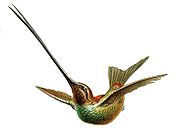Sword-billed hummingbird
| Sword-billed hummingbird | ||||||||||
|---|---|---|---|---|---|---|---|---|---|---|

Sword- billed hummingbird ( Ensifera ensifera ) |
||||||||||
| Systematics | ||||||||||
|
||||||||||
| Scientific name of the genus | ||||||||||
| Ensifera | ||||||||||
| Lesson , 1843 | ||||||||||
| Scientific name of the species | ||||||||||
| Ensifera ensifera | ||||||||||
| ( Boissonneau , 1839) |
The sword- billed hummingbird ( Ensifera ensifera ) is a species of bird in the hummingbird family. It has the longest beak of all known hummingbird species.
features
The sword-billed hummingbird reaches a length of 17 to 22.8 centimeters. Of this, 9 to 11 centimeters fall on the beak, which is longer than the body. The weight is 12 to 15 grams. The black beak is straight and slightly curved upwards. The plumage of the male is predominantly dark green. There is a white pigmented area behind the eye. The head is copper-red, the throat blackish. The chest and flanks are glittering emerald green. The belly is dark gray. The black tail is forked. The female is similar to the male, but has a lighter underside. The throat and stomach are washed out gray and have a green disc pattern. The tail is less forked. The juvenile birds resemble the females.
Occurrence

The distribution area of the sword-billed hummingbird extends in the Andes from western Venezuela via Colombia, Ecuador, Peru to northeastern Bolivia.
habitat
The sword-billed hummingbird can be found in moist to semi-moist high mountain forests, on the edges of forests and occasionally in bushy areas in the Páramo at altitudes between 1,700 and 3,500 meters. It is most common at altitudes between 2,500 and 3,000 meters.
Foraging
The preferred forage plants of the species include the genera Aethantus , Fuchsia and Salpichroa and the species Datura sanguinea , Datura tatula , Passiflora mixta , Passiflora pinnatistipula , Passiflora molissima and Passiflora floribunda . He drinks the nectar from the long, hanging flower crowns. Insects are also part of the diet, which he catches with a wide-open beak in sailor style .
Reproduction
There is no reliable information about the breeding biology. According to an unconfirmed observation, a female is said to have defended her nest in April. Another dubious description is that the moss nests are in trees at a height of 15 meters.
hikes
The sword-billed hummingbird is a resident bird. In the Colombian Central Cordillera, it flies between July and September at altitudes above 3,000 meters.
status
The sword-billed hummingbird is listed by BirdLife International in the “ Least Concern” category. It is considered to be locally frequent. On the Río Oyacachi, it is one of the main attractions for ecotourists . If usable forage plants are available, it also adapts to habitats cultivated by humans. These birds keep visiting the garden near the mountain hotel Los Frailes near Mérida , Venezuela . At the beginning of the 20th century it was still very common in the suburbs of Quito . It is found in several protected areas, including the Munchique National Park and the Pasachoa Reserve in Colombia, as well as the Cajas National Park and Podocarpus National Park in Ecuador.
Etymology and history of research
Auguste Boissonneau first described the hummingbird under the name Ornismya ensifera . A year later, the first illustration by Jean-Gabriel Prêtre (1768–1849) appeared in the Magasin de zoologie, d'anatomie comparée et de paleontologie . The engraving was provided by Davesne ( bl. 1835–1860) and the printing by N. Rémond.
The word "ensifera" is composed of the Latin words "ensis" for "sword" and "ferre" for "to carry".
literature
- J. Del Hoyo, A. Elliot, J. Sargatal (Eds.): Handbook of the Birds of the World . Volume 5: Barn-Owls to Hummingbirds. Lynx Edicions, 1999, ISBN 84-87334-25-3 .
- Dale Hartwell Clayton, Peter Cotgreave: Relationship of bill morphology to grooming behavior in birds . In: Animal Behavior . tape 47 , no. 1 , 1994, p. 195–201 (English, online [PDF; 912 kB ; accessed on December 17, 2013]).
- James A. Jobling: Helm Dictionary of Scientific Bird Names . Christopher Helm, London 2010, ISBN 978-1-4081-2501-4 .
- Auguste Boissonneau: Nouvelles espèces d'Oiseaux-Mouches de Santa-Fé de Bogota . In: Revue Zoologique par La Société Cuvierienne . tape 2 , 1839, p. 354–356 ( online [accessed December 17, 2013]).
- Auguste Boissonneau: G. Oiseau-mouche. Ornismya. Lesson, O.- M. Porte-epée. O. ensifera. Boissonneau . In: Magasin de zoologie, d'anatomie comparée et de palaeontologie . Volume Oiseaux, plate 15, 1840, p. 1–2 ( online [accessed December 17, 2013]).
Individual evidence
- ↑ Auguste Boissonneau (1839), p. 354.
- ↑ Auguste Boissonneau (1840), plate 15
- ↑ James A. Jobling, p. 146.
Web links
- Ensifera ensifera inthe IUCN Red List of Threatened Species 2013.2. Listed by: BirdLife International, 2012. Retrieved December 17, 2013.
- BirdLife International: Species Factsheet - Sword-billed Hummingbird ( Ensifera ensifera ) . Retrieved December 17, 2013.
- Videos, photos and sound recordings for Sword-billed Hummingbird (Ensifera ensifera) in the Internet Bird Collection
- Sword- billed hummingbird ( Ensifera ensifera ) at Avibase; Retrieved December 17, 2013.
- Ensifera ensifera in the Integrated Taxonomic Information System (ITIS). Retrieved December 17, 2013.
- xeno-canto: Sound recordings - Sword-billed Hummingbird ( Ensifera ensifera )


